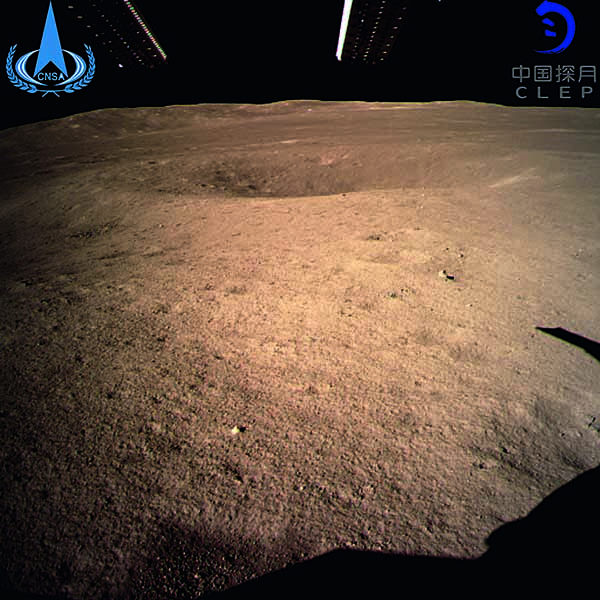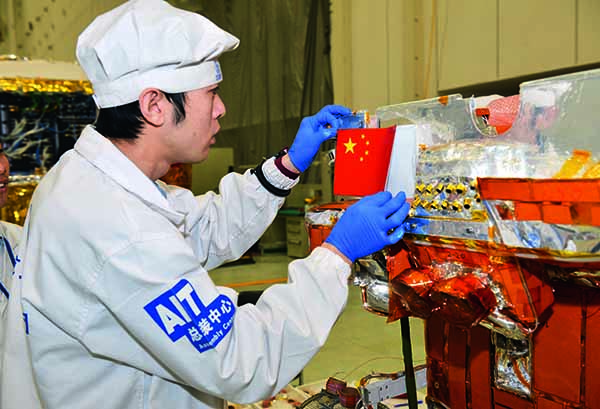Chang’e-4 Mission: The Far Side of Technology

In January 3, 2019, China’s Chang’e-4 lunar probe completed a soft landing on the far side of the moon before carrying out a series of scientific tests.
The pioneering landing marked an unprecedented step for space exploration and a major innovation of space exploration technologies, evidencing the innovation capacity of China’s space program. The same day, NASA Administrator Jim Bridenstine tweeted: “Congratulations to China’s Chang’e-4 team for what appears to be a successful landing on the far side of the moon. This is a first for humanity and an impressive accomplishment!”
Because the moon is tidally locked—a single rotation of its axis takes the same amount of time as a single orbit around Earth—its far side is always facing away from Earth. Consequently, we can only see the near side of the moon from Earth.
On October 7, 1959, the Soviet Union’s Luna 3 probe transmitted the first images of the far side of the moon. In 1968, as the U.S. manned spacecraft Apollo 8 orbited the moon, astronauts aboard saw the far side with their own eyes for the first time. By the end of 2018, countries around the world had launched more than 100 lunar probes, including over 60 lunar landers, but none achieved a soft landing on the far side of the moon as China’s Chang’e-4 probe did.
In general, the far side and near side of the moon contrast each other sharply. The crust on the far side is thicker than that on the near side, and the two sides also differ in terms of material composition, topography and age of rocks. Scientists have yet to reach consensus on explaining such differences. Finding an answer to this unsolved question is meaningful for humans to understand the moon and even the universe.
Discoveries related to the far side of the moon are conducive to advancing moon-based scientific research. The far side of the moon is free of disturbances caused by Earth’s radio waves, making it the best place for radio astronomical observations. Low-frequency moon-based radio astronomical observations can help mankind better probe the detailed evolution of the moon and study the origin of celestial bodies and the universe. Surveys on the lunar surface environment are conducive to the research of particle radiation and solar wind.
The moon is abundant in mineral and energy resources. One purpose of mankind’s lunar exploration is to utilize its resources. In recent years, countries including the United States have consecutively formulated plans to survey and research resources on the far side of the moon. Through scientific surveys of the landing zone, the Chang’e-4 probe provided valuable first-hand information for the exploration and utilization of lunar resources.
The unprecedented landing of the Chang’e-4 probe on the far side of the moon overcame three major technological challenges: First, soft landing in a zone with complex topographical conditions. Compared to the comparatively flat landing zone for Chang’e-3, the South Pole-Aitken Basin where Chang’e-4 landed features rugged terrains with large and dense impact craters, which meant stricter requirements for selection of the landing location and accuracy of landing maneuvers. The second challenge was control communication. Radio signals from Earth cannot directly reach the far side of the moon because it always faces away from Earth. Therefore, communication between Chang’e-4 and Earth requires assistance of the relay satellite Queqiao (Magpie Bridge) that hovers in the L2 halo orbit. The relay satellite features an umbrella-like antenna nearly five meters in diameter when extended. It is the largest diameter for a communication antenna on a deep-space probe in human history. The third challenge was designing automated roving technology specifically for the far side of the moon. Due to a lengthy history of meteorite impacts, the far side of the moon has a rougher environment than the near side. Chinese scientists designed eight modes for the rover, including sensing, moving, detecting, recharging, safe, sleep, lunar day switching to lunar night, and lunar night switching to lunar day, to adapt to different working environments and conditions. The technological breakthroughs achieved by Chang’e-4 laid groundwork for future lunar exploration as well as the exploration of other planets in the solar system such as Mars.

The Chang’e-4 mission involved extensive international cooperation which resulted in a model for international collaboration in space exploration. The payloads on the Chang’e-4 probe include a neutron radiation detector developed by Germany and a neutral atom detector developed by Sweden. Moreover, a low-frequency explorer developed by the Netherlands was installed on the relay satellite Queqiao. Those international payloads, coupled with those independently developed by China, have already carried out various scientific tests on the far side of the moon.
After the Chang’e-4 mission, China will launch the Chang’e-5 unmanned probe to accomplish a series of tasks including bringing lunar samples back to Earth. A new wave of global lunar exploration is about to happen, and China is poised to play a greater role in deepening human understanding of the moon and the universe.
The author is a senior researcher with Techxcope, a technological consulting agency.